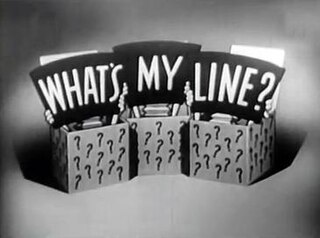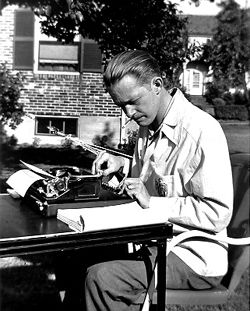This article needs additional citations for verification .(July 2019) |
Murder at Midnight is an old-time radio show featuring macabre tales of suspense, often with a supernatural twist. It was produced in New York and was syndicated beginning in 1946. The show's writers included Robert Newman, [1] Joseph Ruscoll, Max Ehrlich, and William Morwood, [2] and it was directed by Anton M. Leader. [2] The producer was Louis G. Cowan. [3] The host was Raymond Morgan, who delivered the lines of introduction over Charles Paul's organ theme: "Midnight, the witching hour when the night is darkest, our fears the strongest, and our strength at its lowest ebb. Midnight, when the graves gape open and death strikes."
Contents
A total of 50 episodes were produced. [4] Ten shows were syndicated and rerun on Mutual in 1950.
| Ep | Title | Production Date | Original Airdate | Written by |
|---|---|---|---|---|
| 1 | "The Dead Hand" | April 30, 1946 | September 16, 1946 | Robert Newman |
| A concert pianist loses his left hand in an accident. He meets a pickpocket with very nimble hands and once the pickpocket is dead, he won't need them anymore. | ||||
| 2 | "The Man Who Was Death" | April 30, 1946 | September 23, 1946 | Robert Newman |
| A sculpture tries to perfect his sculpture of Death by putting himself in Death's shoes. | ||||
| 3 | "Secret of XR3" | May 9, 1946 | September 30, 1946 | Max Ehrlich |
| A man, tired of being 3 feet tall, takes a dose of XR3 to make himself grow. How much taller will he get? What will happen to those who laugh at him now? | ||||
| 4 | "Wherever I Go" | May 12, 1946 | October 7, 1946 | William Morwood |
| Gordon grows tired of his rich wife Ellen but knows she will never divorce him. He gets her to buy some rat poison, gives the cook the night off and has his wife write a suicide note for a character in his book. After she dies he believes he is finally free until a suspicious stranger starts following him. | ||||
| 5 | "Trigger Man" | May 12, 1946 | October 28, 1946 | Max Ehrlich |
| "Chicken" Charlie Nix is a hold up thug who has never been able to fire his gun. The mob boss takes him to a doctor who tells him he only has 6 months to live. | ||||
| 6 | "Death's Goblet" | May 23, 1946 | October 21, 1946 | Sigmund Miller |
| Harvey's friend Arthur brings back a mysterious goblet from his travels with a legend that all who drink from it will commit murder. Harvey is not only interested in the goblet but he thinks his rich business partner Gerald and Gerald's lovely wife Susan might be interested as well. | ||||
| 7 | "The Heavy Death" | May 23, 1946 | November 4, 1946 | Robert Newman |
| A mad scientist makes himself “heavy” (as in heavy water, or uranium.) His might crushes men’s skulls! He also has a death ray! But the ghost of a man with a crushed skull comes for revenge! | ||||
| 8 | "Nightmare" | May 28, 1946 | November 11, 1946 | Joseph Roscoll |
| A woman’s murderous nightmare is explained away by her husband’s dream analysis, from hamburgers to their anniversary. But once she falls asleep, the phone rings… | ||||
| 9 | "The Dead Come Back" | May 28, 1946 | November 18, 1946 | William Morwood |
| 10 | "Terror Out Of Space" | June 4, 1946 | February 24, 1947 | Robert Newman |
| 11 | "The Creeper" | June 11, 1946 | November 25, 1946 | Joseph Roscoll |
| 12 | "The Man Who Died Yesterday" | June 11, 1946 | June 30, 1947 | William Morwood |
| 13 | "Till Death Do Us Part" | June 11, 1946 | December 9, 1946 | Joseph Roscoll |
| 14 | "Murder is a Lonely Business" | June 16, 1946 | December 16, 1946 | William Morwood |
| 15 | "The House Where Death Lives" | June 16, 1946 | December 23, 1946 | Robert Newman |
| 16 | "The Kabala" | July 28, 1946 | December 31, 1946 | Robert Newman |
| 17 | "Ace of Death" | July 28, 1946 | January 6, 1947 | Max Ehrlich |
| Based on Robert Louis Stevenson's The Suicide Club John Evans: ill, broke and without family and friends decides to jump off a bridge to put an end to it all. A man, Fredrick Whitney, pulls him off and tells him that jumping off a bridge is rather dull and invites him to join the Hereafter club where a card game determines who will be killed and who will be the killer. | ||||
| 18 | "The House Time Forgot" | August 7, 1946 | January 13, 1947 | Sigmund Miller |
| 19 | "Death Tolls a Requiem" | August 7, 1946 | March 17, 1947 | Max Ehrlich |
| 20 | "The Thirteenth Floor" | August 16, 1946 | January 27, 1947 | Winifred Wolfe |
| 21 | "The Mark of Cain" | August 24, 1946 | September 6, 1946 | A. S. Ginnes |
| 22 | "Red Wheels" | August 28, 1946 | September 13, 1946 | Jack Gordon |
| 23 | "The Line Is Dead" | September 8, 1946 | April 7, 1947 | Bafe Blau |
| 24 | "Death Across the Board" | September 18, 1946 | Robert Newman | |
| 25 | "Murder Out Of Mind" | November 6, 1946 | Sigmund Miller | |
| 26 | "Death Worshipper" | September 25, 1946 | March 10, 1947 | Jay Williams |
| 27 | "We Who Are About To Die" | October 11, 1946 | April 21, 1947 | A. S. Ginnes |
| 28 | "The Black Curtain" | October 11, 1946 | February 10, 1947 | Max Ehrlich |
| 29 | "The Ape Song" | October 11, 1946 | April 13, 1947 | Peter Martin |
| 30 | "The Man With The Black Beard" | October 11, 1946 | February 3, 1947 | Sigmund Miller |
| 31 | "Death Ship" | October 18, 1946 | April 14, 1947 | William Morwood |
| 32 | "Outcast" | October 18, 1946 | February 17, 1947 | Max Ehrlich |
| 33 | "Fatal Interruption" | October 18, 1946 | July 14, 1947 | Bafe Blau |
| 34 | "The Dispossessed" | October 24, 1946 | July 21, 1947 | Jack Gordon |
| 35 | "The Black Swan" | October 31, 1946 | August 18, 1947 | Leon Meadow |
| 36 | "Island Of The Dead" | November 6, 1946 | May 5, 1947 | Robert Newman |
| 37 | "The Dark Chamber" | November 6, 1946 | May 26, 1947 | Robert Newman |
| 38 | "Death Is No End" | November 13, 1946 | June 2, 1947 | A. S. Ginnes |
| 39 | "The Dark Cellar" | November 13, 1946 | June 9, 1947 | Max Ehrlich |
| 40 | "Murder Is Not Enough" | November 13, 1946 | June 16, 1947 | Bafe Blau |
| 41 | "The Face Of The Dragon" | November 20, 1946 | July 7, 1947 | Jack Bordun |
| 42 | "The Man Who Died Again" | November 20, 1946 | Robert Newman | |
| 43 | "City Morgue" | November 27, 1946 | May 19, 1947 | Winifred Wolfe |
| 44 | "Terror" | November 27, 1946 | February 24, 1947 | Joseph Ruscoll |
| 45 | "The Corridor Of Doom" | December 4, 1946 | May 12, 1947 | Robert Newman |
| 46 | "Appointment" | December 4, 1946 | July 28, 1947 | Winifred Wolfe |
| 47 | "Glory Train" | December 11, 1946 | August 4, 1947 | Robert Newman |
| 48 | "A Week Ago Wednesday" | December 11, 1946 | Winifred Wolfe | |
| 49 | "The Living Dead" | December 20, 1946 | April 28, 1947 | Robert Newman |
| 50 | "The Face" | December 20, 1946 | August 11, 1947 | Paul Monash |











